Roasted leg of lamb recipe that delivers tender meat covered with a delicious Dijon mustard-rosemary-garlic crust, along with flavorful potatoes.
Go straight to the Recipe Card or
Read on for relevant tips and step-by-step pictures and video (2 mins)
Slow-Roasted Lamb
This classic leg of lamb recipe is all about tender, flavorful meat that can literally be pulled apart with a fork but still holds its shape for an appetizing, Easter or Christmas holiday worthy presentation.
We slather a Dijon mustard and rosemary centered lamb leg marinade all over the meat and let a few hours of no fuss, low and slow roasting do their magic. Simplicity cannot be beat as far as lamb is concerned.
While you do not have to add potatoes and can skip the step, we recommend that you decide in favor of cooking them. They soak up some of the stock with which the roasting pan is filled to provide moist heat for the leg of lamb and are basted by the slowly melting fat and collagen from the meat. The flavor and texture they develop in the process are not to miss!
Ingredients for Slow Cooked Lamb Leg

A raw New Zealand bone-in leg of lamb.
- Leg of lamb. You can slow roast a bone-in leg of lamb, regardless of cut style (chump or shank on/off) or a rolled boneless leg of lamb. The latter will take less time.
- Gold potatoes. Either use whole baby Gold potatoes or Yukon golds, thickly sliced. They hold shape their well and are very slow cooking friendly.
- Chicken stock & lager (optional). To provide gentle moist heat as the meat slowly roasts. We like to add a little bit of German or Czech pilsner to the potatoes because it brings about a nice, herbal touch to the overall flavor. You can substitute with more stock or water.
- Dijon mustard, fresh rosemary, garlic, salt & pepper and olive oil. See comments below about the marinade.
Lamb Dijon Mustard Marinade
You do not have to marinate the leg of lamb ahead of time – this paste like marinade sticks to the surface, courtesy of the Dijon mustard in it, and as the lamb cooks it is absorbed by the meat and both flavors it and creates an appetizing thin crust.
If you are a fan of strong flavors feel free to make a double batch – use most of the marinade before you begin roasting the lamb leg and apply the reserved part towards the end of the cooking process when you uncover the meat, for a thicker and more flavorful crust.
Step-by-Step Workflow for This Leg of Lamb Recipe
- Prep. It is important to chop the rosemary leaves as small as possible. Mix the marinade ingredients, pat dry the leg of lamb and score the fattiest parts (trim any excess fat, but leave some as it will flavor the meat). Rub the marinade all over.
- Slow roast. Add chicken stock to a roasting pan, place a roasting rack on top and center the leg of lamb on top, fat side up. Cover with foil, as tightly as you can and roast at 300-325 F for about 3 hours. Check progress (see cooking times below). Add more liquid if needed, cover again and continue slow roasting.
- Add potatoes (optional). Cut the potatoes lengthwise in thick slices or if using baby Gold potatoes halve any larger ones. Add them to the roasting pan when you estimate that there are just under two hours left of slow roasting. Add the lager at this time or a bit of extra stock or water.
- Finish slow roasting. Slow roast for another hour, then remove the foil and return to oven to brown. The leg of lamb will get a nice crust and the potatoes will finish cooking. Tent lamb leg and allow to rest a few minutes before serving.
A Slow Roasted Leg of Lamb Gets More Tender the Longer You Cook It
With this recipe you are not stressing over a pink center or internal temperature. Because there is moisture and the meat is covered you are also not concerned about it drying out or the outside browning too fast.
Your singular goal is tender, flavor saturated meat and this is in direct proportion to the time the lamb leg spends roasting at low temperature.
The connective tissues melt turning into liquefied collagen which saturates the meat with flavor. The marrow (when using bone-in leg) melts and flavors the pan juices and potatoes. The slowly melting fat gradually moisten the meat and makes it taste richer and succulent.
The total cooking time required to slow roast a lamb leg to fork tenderness depends on:
- Size of lamb leg. Bigger takes longer. Budget about 50-60 minutes per pound of lamb, as a guideline, with adjustments per below.
- Boneless or bone-in cut. The boneless leg will cook faster. The bone-in leg will take longer, especially if it has both the shank and the chump attached.
- Oven strength/calibration. If you know your oven to be particularly strong adjust the temperature as needed.
TIP: You will need about 100 minutes for the thick cut gold potatoes to cook through, at about 300-325 F. Add them only after you have checked that the leg of lamb is quite tender already. If you determine that the potatoes are cooked but the lamb could use a bit extra time, simply remove the potatoes and keep warm and let the lamb cook further.
Serve the Roast Leg of Lamb
To serve first scoop out the potatoes with a slotted spoon and arrange them on an appropriately sized platter. Carefully lift the rested lamb leg (meat will be very tender) and place it over the potatoes. Garnish with a bit of fresh rosemary.
Fresh greens or lettuce based salads make a wonderful companion to the dish as well as this yogurt sauce.
TIP: Save all the delicious pan juices from the roasted lamb and use them as a sauce. You do not even need to make a gravy with them – simply transfer all the pan liquids to a small bowl or gravy boat and serve it nearby the platter with the leg of lamb.
Reheat Leftover Lamb Leg Meat for Gyros
If you have leftover meat, pull it off the bone and refrigerate or freeze for another meal. We love to make gyros with reheated lamb leg.
Thaw the meat in the fridge overnight (if you froze it), give it a rough shred and reheat in a non-stick pan over medium heat and with an added tablespoon of olive oil. Season with a bit of dried oregano and sauté for a couple of minutes, then add 2-3 tablespoons of water and let it cook a bit longer. As the water evaporates it moistens the tender lamb pieces and they are perfect for folding into a pita bread.
You Might Also Like
Grilled Leg of Lamb
Authentic Lamb Skewers Shish Kebab
Slow Roasted Lamb Breast
Greek Slow Roasted Lamb Shoulder
Smoked Boneless Lamb Leg
Grilled Lamb Steak
Video Demonstration
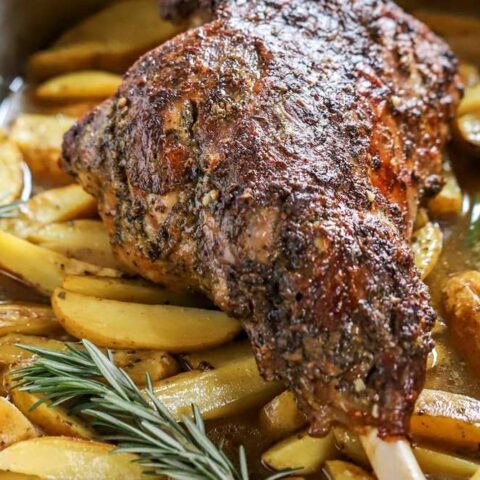
Fork Tender Leg of Lamb (Slow Roasted with Potatoes)
Fork tender leg of lamb slow roasted to perfection, with potatoes. Easy process and flavors galore, the exact roasting time depends on the size of lamb leg and whether bone-in or boneless.
Ingredients
- 1 leg of lamb, about 5 lbs*
- 2 cups chicken stock
- 4 cloves garlic, minced or pressed
- 2 tbsp Dijon mustard
- 3-4 sprigs rosemary, chopped very fine + more for garnish
- 2 tbsp olive oil
- 1 tbsp coarse salt
- 1 tsp pepper
- 3 lbs Gold potatoes (baby gold or Yukon gold)
- 1 cup lager**
Instructions
- Preheat oven to 300-325 F depending on how strong (300 F for fan assisted oven).
- Pat dry the leg of lamb, score the fatty parts with a sharp knife. Mix the finely chopped rosemary, minced garlic, Dijon mustard, salt and pepper and olive oil to form a paste. Rub all over the lamb.
- In a large roasting pan pour the chicken stock. Place the roasting rack on top and position the prepared leg of lamb in the center of the rack. Cover with aluminum foil and slow roast for about 3 hours***.
- Uncover the lamb and check for progress - bone(s) should be cleanly exposed and meat just starting to become tender and pull away. Add the potatoes, replace rack with lamb leg and add lager (or extra stock or water). Cover and roast for another 1 to 1.5 hours, depending on how large the leg.
- Remove the foil completely and continue roasting for about 30-45 extra minutes in order for a crust to form and the meat to become completely tender (test with fork to see if it easily falls apart).
- Before serving, loosely tent the lamb leg with foil and allow to rest for a few minutes. Save all the pan juices and serve alongside the lamb and potatoes - they make a delicious sauce, no gravy needed.
Notes
*Depending on size and cut a lamb leg's weight can average from 4 to about 6.5 lbs. If chump and shank are attached it will weigh more, if boneless considerably less. Total slow roasting time will depend on the size/weight/style of cut. Budget about 50-60 minutes per pound of lamb meat. Read post for more details.
**German or Czech pilsner, Munich helles or American craft lager recommended.
***If your pan does not have roasting rack, slice an onion across into 3 thick circles, place them at bottom of pan and rest meat on top. If the leg of lamb weighed less than 4 lbs (usually when boneless) reduce this time increment to 2.5 hrs.
Refer to the post for helpful tips regarding total roasting time, oven strength and more.
Recommended Products
We are affiliates for Amazon and other vendors and qualifying purchases you make support our blog at no cost to you.
Nutrition Information:
Yield: 8 Serving Size: 1Amount Per Serving: Calories: 961Total Fat: 51gSaturated Fat: 20gTrans Fat: 0gUnsaturated Fat: 27gCholesterol: 265mgSodium: 1265mgCarbohydrates: 40gFiber: 4gSugar: 3gProtein: 79g
Nutrition assumes 8 servings per leg of lamb, but larger cuts can result in more servings, therefore overstated information. Potatoes included in nutritional info.

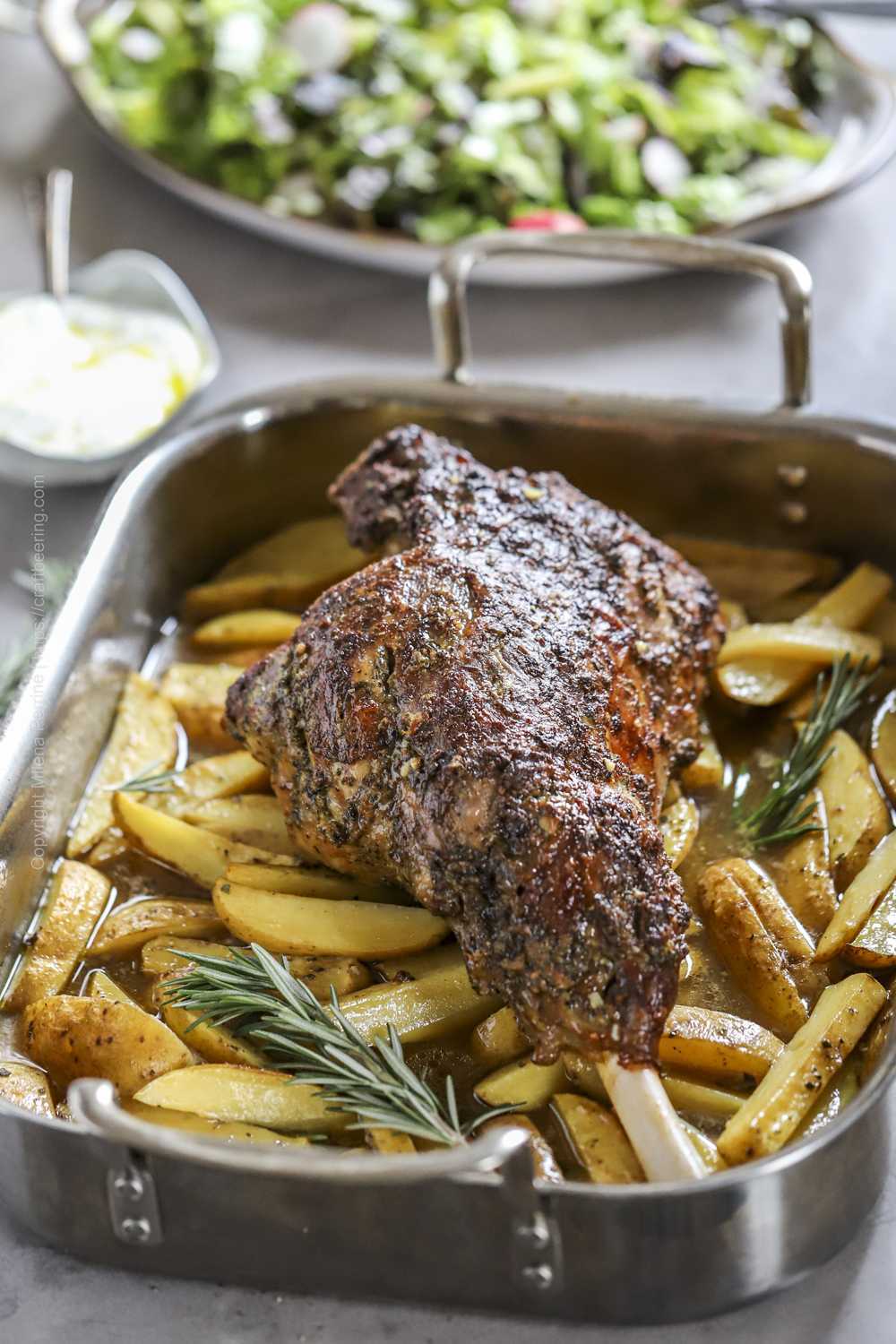


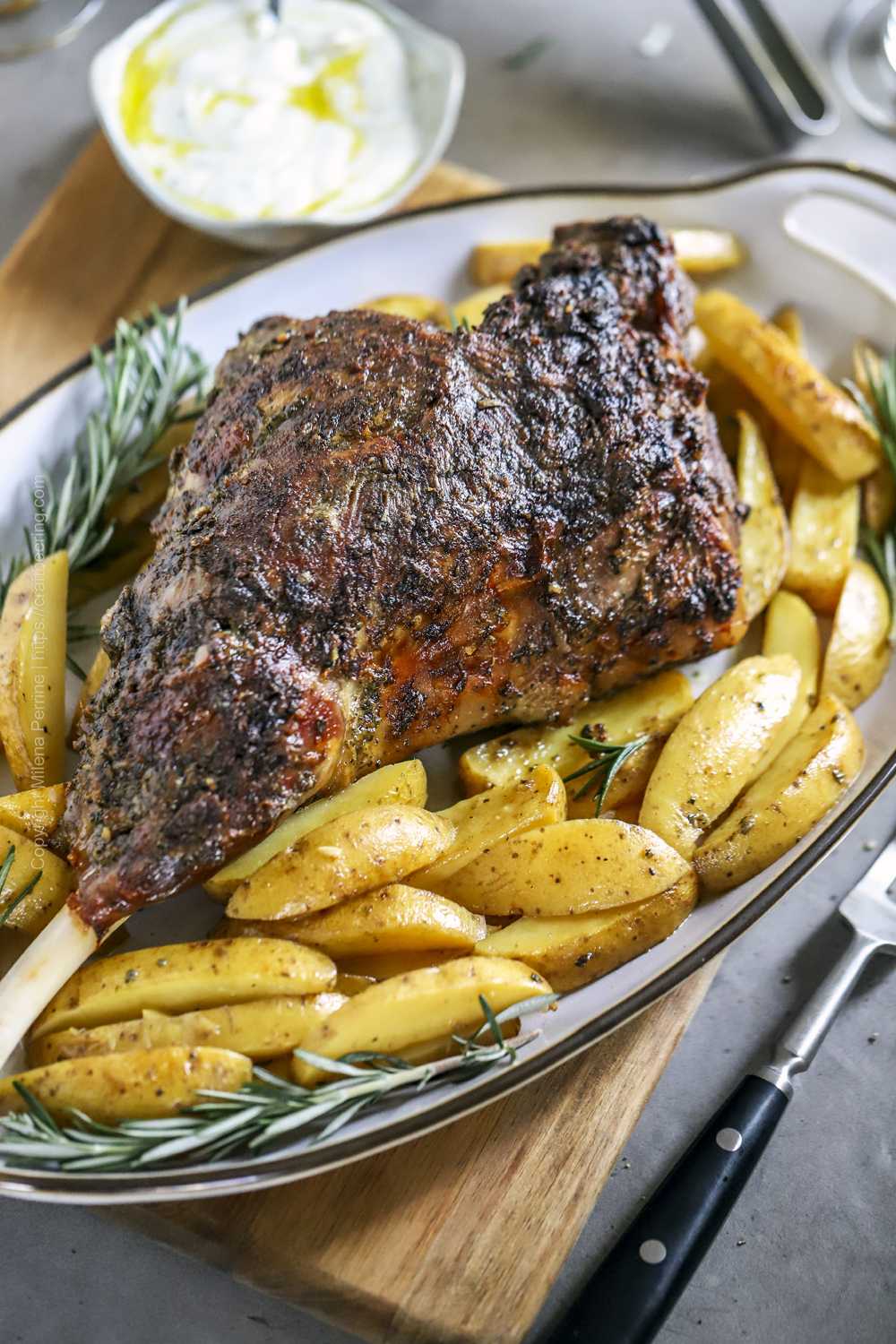
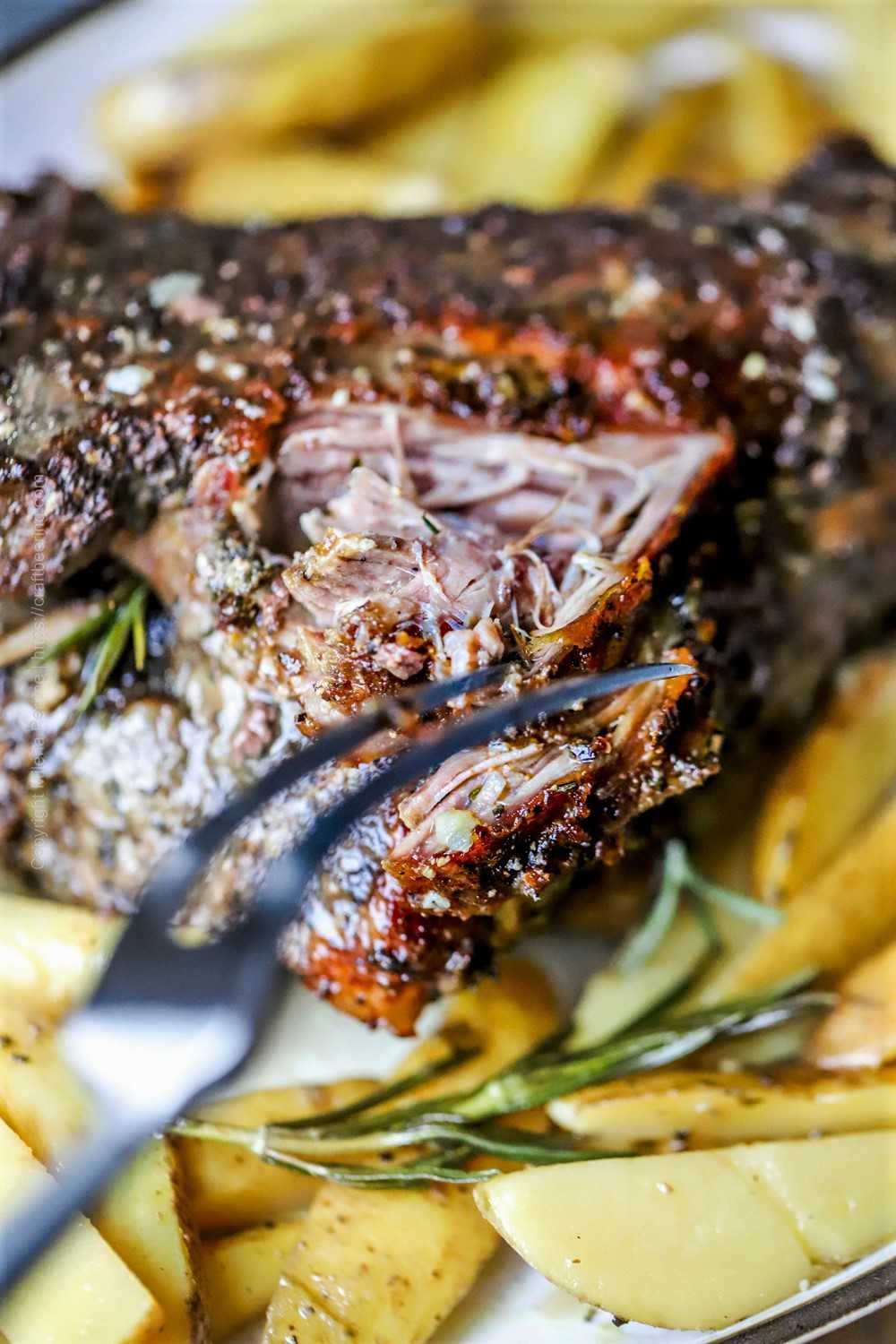
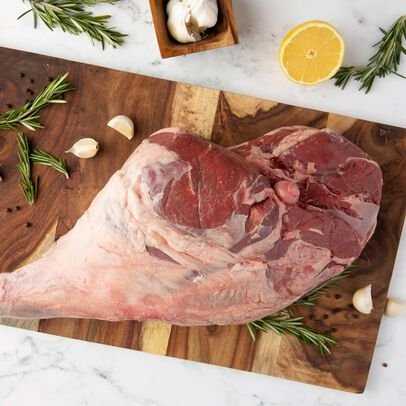
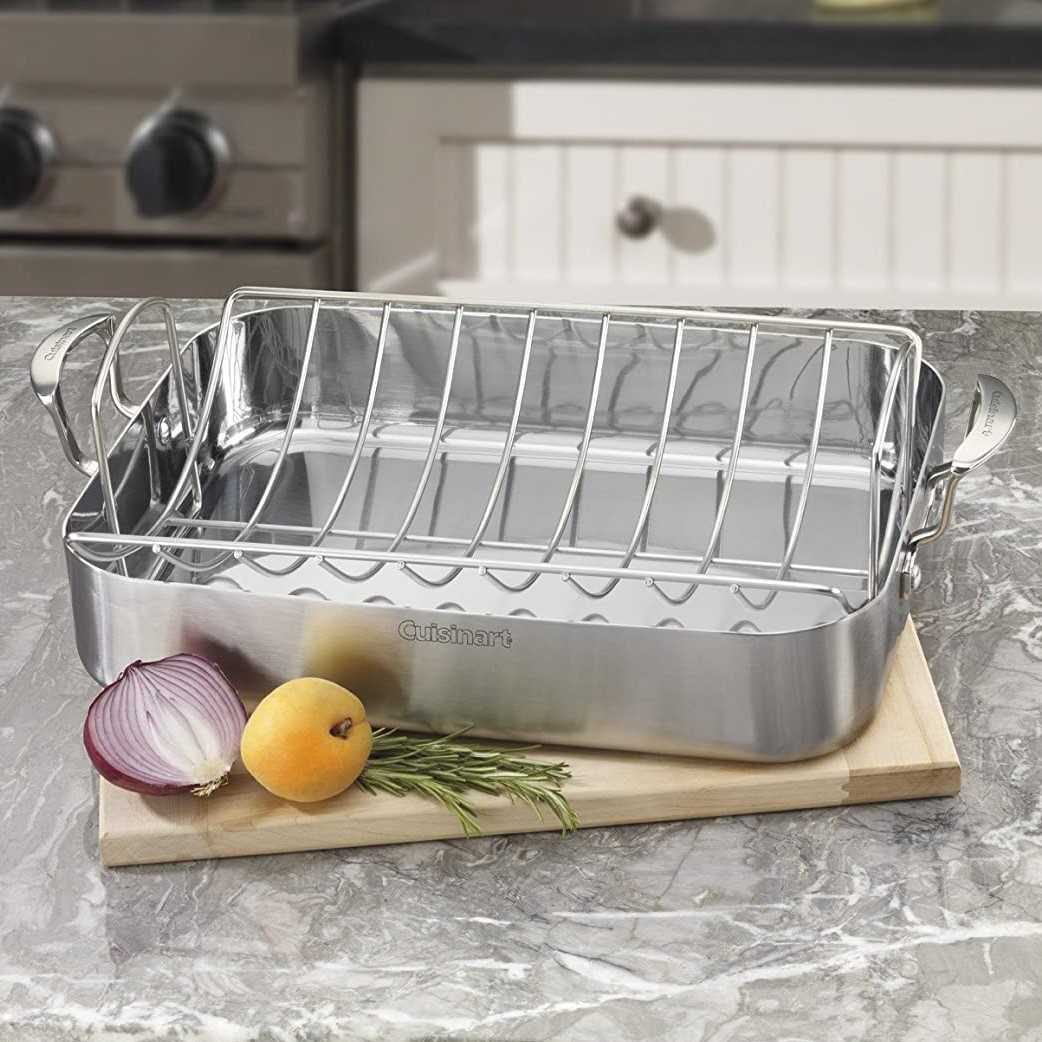
Dudley C Richardson says
I tried this recipe but became concerned about cooking the lamb for 3 hours at 300°. I check the temperature at a little over an hour and it was in the 140s. Removed the foil and did a 5 minute broil on each side. Used the chicken broth and onions in the pan to make a gravy by bringing it to a boil and adding some flour.
Craft Beering says
Yes, 300 is low enough to for prolonged cooking of a bone-in leg of lamb, until the meat effotlessly pulls away from the bone.
Jennifer @ Seasons and Suppers says
Just perfect! A wonderful meal with the potatoes and loving the idea of leftover lamb gyros 🙂